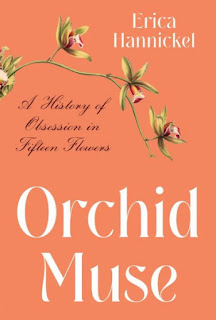 and Empire of Vines: Wine Culture in America, she writes for Orchids magazine and blogs at www.orchidmuse.com. She lives in Wisconsin.
and Empire of Vines: Wine Culture in America, she writes for Orchids magazine and blogs at www.orchidmuse.com. She lives in Wisconsin.
Hannickel applied the "Page 99 Test" to Orchid Muse and reported the following:
The Page 99 Test is an excellent one for Orchid Muse—we see the whole ecosystem of the book encapsulated in this slice. The page comes near the end of Chapter 6, “The Wind Orchid,” wherein I detail the international circuits of one of Japan’s most beloved orchids through history—Vanda falcata, also known as Neofinetia falcata, the wind orchid, or the Samurai orchid—had traveled throughout Europe and America by the early 19th century. Page 99 describes how the Japanese grew these orchids since the 18th century: on traditional moss mounds, in ornamental pots used only for wind orchids, with delicate wire cages over them, and compares the practice to how many contemporary lovers of neofinetia orchids display them and continue to study their vaunted Samurai history. Neofinetias are one of the most collectible and well-loved orchids today, and interestingly, very little has changed in their culture over the centuries. I write “There is simply no other orchid in circulation today that carries with it so many cultural components. Its only likeness, really, is to another esteemed Japanese horticultural export: bonsai.”Visit Erica Hannickel's website.
If there is one element of the book page 99 does not represent very well, it is the multiple meanings of muse in Orchid Muse. On this page, we have the orchid as muse in that it beguiles humans into centuries of attentive cultivation and global trade. It does not offer what much of the rest of the book does, however—the deeper stories of humans, most of them women, people of color, and others previously left out of orchid history—whose lives were reshaped by coaxing orchids into bloom in adverse environments for wildly varied reasons. Frida Kahlo used orchids to represent the pain of a lost pregnancy; the heiresses of New York’s Gilded Age to flaunt their extreme wealth; Chinese Empress Cixi to emphasize her imperial power; Jane Loudon to advocate for women’s rights and freedom; French Empress Eugenie to punctuate her role as the 19th century’s ultimate fashion maven. As it turns out, throughout time, humans have sung to their orchids as much as orchids to their humans.
--Marshal Zeringue



